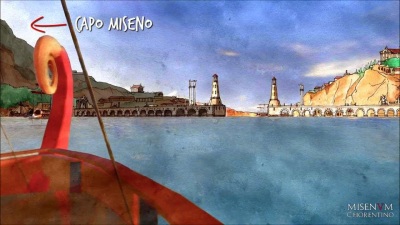A small promontory jutting into the Tyrrhenian Sea from the coast of Campania in Italy on the Bay of Naples. Misenum was situated in the region of Cumae, Bauli, Baiae and Puteoli. Its name was derived supposedly from Misenus, the trumpeter of Aeneas, who drowned in the waters of its bay. For many years the Campanians were threatened by pirate sorties out of the Tyrrhenian Sea. These attacks were a leading reason for Pompey’s brilliant campaign of 67 B.C. against the pirates in the Mediterranean.
Conference of Misenum
Meeting held in 39 B.C. between the Triumvirs Marc Antony and Octavian (Augustus) on one side, and Sextus Pompey, the pirate son of Pompey the Great. Sextus had proven a surprisingly successful pirate chief, whose ships commanded much of the Mediterranean, threatening all of the Italian coast as well as the provinces, and wielding the power to cut off vital shipments of grain from Africa to Rome. Following the Treaty of Brundisium in 40 B.C., both Antony and Octavian had recognized the need to deal with Sextus Pompey. They were, however, not in a position to hound him from the seas and consequently agreed to a discussion. The first encounter at Puteoli ended in nothing, but in the spring of 39, real progress in negotiations led to the Treaty of Misenum. By the terms of this agreement, Sextus promised to leave the corn supply unmolested, to respect the integrity of Italy, return all seized property and to engage in no hostile actions. In return, he received Corsica, Sardinia, Achaea and Sicily, along with vast sums of money as recompense, and a position in the triumvirate. He was also promised eventual augurship and consulship. His status was thus strengthened militarily and politically, although both of his opponents knew that the treaty would not remain intact.
Naval Base
Misenum’s strategic value was clear, and when Augustus reorganized the armed forces of Rome, he chose the spot and its bay to build an excellent harbor.
Misenum was the largest base, Portus Julius, of the Roman navy, since it was the base of the Classis Misenensis, the most important Roman fleet. It was first established as a naval base in 27 BC by Marcus Agrippa, the right-hand man of the emperor Augustus.
Misenum emerged, with Ravenna, as one of the major ports for the Roman Imperial Navy in Italy.
Portus Julius (alternately spelled in the Latin “Iulius”) was the home port for the Roman western imperial fleet, the classis Misenensis, named for nearby Cape Miseno. (The eastern fleet was in Ravenna.) The port was located at the western end of the gulf of Naples and other than the waters of the bay, itself, consisted of three bodies of water in the area: Lake Lucrino, Lake Averno, and the natural inner and outer harbor behind Cape Misenum. The port was named for Julius Caesar.
In preparation for the epochal naval battle of Actium, the Romans constructed a ship-building and training facility in the area. After the successful outcome of the battle, the facility was expanded by Caesar Augustus in 37 BC. The various lakes were linked by canals and the area was also joined to nearby Cumae by an underground passage 1 km (0.6 mile) long and wide enough to be used by chariots.
The Romans built new breakwaters and a freshwater reservoir, the Piscina Mirabilis, of unparalleled size. The outer harbor behind Cape Misenum served the active vessels of the Roman navy and provided room for training exercises, while its inner counterpart (to which it was connected by a canal crossed by a wooden bridge) was designed for the reserve fleet and for repairs, and as a refuge from storms. Because of its location, the area controlled the entire Italian west coast, the islands and the Straits of Messina.
Command of the fleet at Misenum was considered a very important step upward in a Roman career. Often marines and sailors could be transferred from Misenum to Rome for special imperial duties or as rigging operators at the Colosseum.
As was true with much of Campania, the community that developed around the bay was a favorite retreat for the most powerful people in Rome. Marius owned a villa there, which passed into the hands of Tiberius. There, in 37 A.D., Gaius Caligula looked on as the aged emperor either died of natural causes or was murdered.
